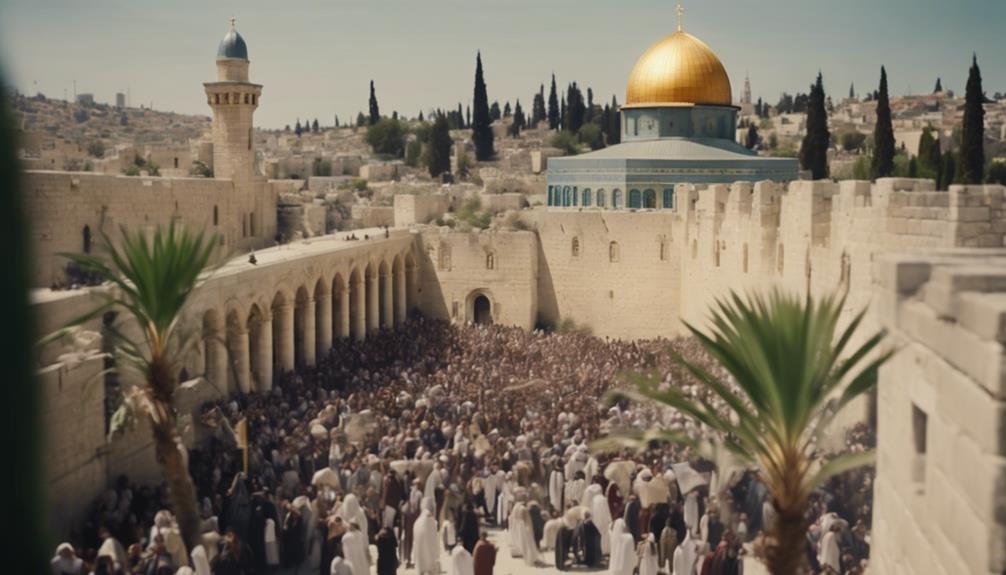As you explore the narratives of Palm Sunday in the Gospels, you’ll notice each account sheds light on different facets of this pivotal event. Consider how Matthew focuses on the fulfillment of prophecy, while John emphasizes the recognition of Jesus as King.
This variation not only enriches our understanding of the event but poses intriguing questions about the perspectives and intentions of the Gospel writers.
What might these differences tell us about the early Christian communities for whom they were written? Reflecting on these distinctions could lead to a deeper appreciation of the complexities within the biblical texts.
Key Takeaways
- Palm Sunday commemorates Jesus Christ’s triumphant entry into Jerusalem, as described in all four Gospels.
- It fulfills the prophecy from Zechariah 9:9 about a peaceful king arriving on a donkey.
- The crowds laid palm branches before Jesus, symbolizing victory and honor, echoing ancient triumphal entry customs.
- Key scriptures include Matthew 21:1-11, Mark 11:1-11, Luke 19:28-44, and John 12:12-19, each providing different perspectives and details.
- This event marks the beginning of Holy Week, leading to Jesus’ crucifixion and resurrection, pivotal events in Christian theology.
Historical Context of Palm Sunday

Palm Sunday marks Jesus’ triumphant entry into Jerusalem, an event steeped in symbolic gestures and prophetic fulfillment. As you delve into this significant day, it’s crucial to ponder the historical backdrop under which these events unfolded.
During this period, Jerusalem was under Roman occupation, a factor that heavily influenced the local cultural customs and the daily lives of its inhabitants.
The Roman influence permeated various aspects of Judean life, instilling a complex layer of governance that often clashed with local traditions and religious practices.
You’d notice how these tensions set the stage for Jesus’ entry, which wasn’t just a religious procession and a subtle act of defiance against the prevailing powers.
The use of palm branches, a symbol of victory and peace in Jewish culture, highlighted a poignant contrast against the Roman symbols of power and domination, making the event deeply symbolic.
Key Gospel Narratives Explored
Exploring the key gospel narratives, you’ll find that each account offers a unique perspective on Jesus’ entry into Jerusalem. The Gospel of Matthew emphasizes the fulfillment of prophecy, showcasing how Jesus’ arrival was predestined.
You’ll notice the crowd’s reaction here; their shouts of ‘Hosanna!’ reflect their recognition of Jesus as the prophesied savior and their hopes for liberation.
Mark’s Gospel focuses more on Jesus’ deliberate actions, like his specific instructions for obtaining the colt. The crowd reactions in Mark are spontaneous and energetic, illustrating the excitement and the high expectations placed on Jesus.
Luke’s narrative provides a broader view, including details about the crowd spreading their cloaks on the road. Here, the crowd’s enthusiasm is palpable, but Luke also introduces a note of foreboding from some Pharisees in the crowd, adding a layer of complexity to the public’s reaction.
John’s account highlights the apostolic perspectives, particularly how the disciples didn’t initially understand the events. Only after Jesus’ glorification do they fully grasp the significance of what had happened, which adds a reflective element to the narrative.
Each Gospel sheds light on different facets of this pivotal moment, offering you a richer understanding of that day’s profound impact.
Symbolism of Palm Branches

The palm branches carried during Palm Sunday hold deep symbolic significance, representing victory and triumph. These branches aren’t just decorative; they’re rich with meaning and history, deeply entrenched in religious and cultural practices.
Historically, palm branches symbolized goodness and victory, and they are prominent in many cultures and religious ceremonies. Here’s how they play a key role in Palm Sunday and beyond:
- Victory Over Evil: In ancient times, warriors and champions were often greeted with palm branches as signs of victory and peace. On Palm Sunday, these branches symbolize Jesus’ triumphal entry into Jerusalem, celebrated as a victory over sin.
- Eternal Life: Palms symbolize immortality and eternal peace because they stay green all year. This ties back to the promise of eternal life through Christ’s sacrifice and resurrection, celebrated in the week following Palm Sunday.
- Ceremonial Uses: Beyond Palm Sunday, palm branches have various ceremonial uses, integrated into many cultural rituals to denote honor and reverence. Palm cultivation has evolved to support these uses, ensuring a steady global supply for religious events and ceremonies.
Thus, the palms you see aren’t just simple foliage but are steeped in deep, enduring symbolism.
Prophecies Fulfilled by Jesus
Jesus fulfilled numerous Old Covenant prophecies throughout His ministry, affirming His role as the Messiah. You’ve likely heard about the Messianic expectations that swirled around Jesus as He walked the earth.
These weren’t just hopeful whispers; they were rooted in specific scriptures that Jesus actively brought to life. For example, consider the prophecy in Isaiah 53, which speaks of a suffering servant who bears the sins of many.
Jesus’ crucifixion mirrors this prophecy, showcasing sacrificial parallels that are hard to dismiss. As you explore these scriptures, you see that Jesus didn’t just happen upon these fulfillments.
Each step He took was a deliberate nod to these ancient promises, revealing His identity to those paying attention. Moreover, Zechariah 9:9 predicts a king coming in peace, humble, and riding on a donkey.
This directly connects to Jesus’ entry into Jerusalem on Palm Sunday, which you might recall is celebrated with palm branches. This event isn’t just a fulfillment of prophecy; it’s a public declaration of His messianic identity, aligning perfectly with the expectations of a deliverer.
These examples are just glimpses. They invite you to investigate deeper, recognizing how intricately Jesus’ life interweaves with prophetic texts, confirming His messianic mission at every turn.
Spiritual Significance and Reflections

Reflecting on Palm Sunday, you discover its deep spiritual significance as a historical event and a moment of personal transformation.
This day marks Jesus Christ’s triumphant entry into Jerusalem, an event that sets the stage for His upcoming passion and resurrection. As you engage in personal reflections during modern celebrations, here’s what you might consider:
- Renewal of Commitment: Just as the crowds laid down palm branches to honor Jesus, you’re invited to lay down your burdens and renew your commitment to follow Him. It’s a powerful metaphor for starting anew, shedding past mistakes, and embracing a path of righteousness.
- Reflection on Sacrifice: Understanding the depth of Jesus’ sacrifice and His journey towards the cross gives you a profound appreciation for the extent of His love and dedication. It urges you to reflect on how you can live a life of sacrifice, prioritizing others’ needs and serving those around you.
- Hope in Triumph: Palm Sunday isn’t only about the beginning of a difficult week and the promise of victory—Jesus’ resurrection. It instills hope in your heart, reminding you that no matter the challenges, triumph is possible with faith.
Conclusion
As you reflect on Palm Sunday, remember it’s not just about historical events but also personal renewal and spiritual depth. Jesus’ triumphal entry into Jerusalem, marked by palm branches and prophecies, invites you to celebrate His victory and peace.
Embrace this time to deepen your faith and recognize the sacrifices made. Let this day renew your commitment to follow His path, filled with hope in the resurrection and the eternal life promised to you.
Recommended Articles:
Palm Sunday Prophecy: Symbolism and Significance
Greek Palm Sunday: Embracing Ancient Customs and Modern Joy
Palm Sunday Blessings: Inspiring Quotes for a Sacred Journey

